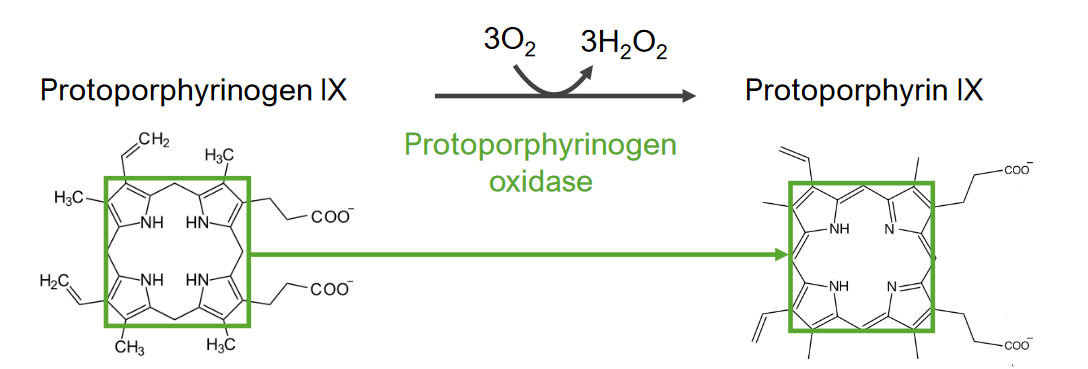Playlist
Show Playlist
Hide Playlist
Regulation of Iron Transport
-
Slides HemeSynthesis,IronTransport,Storage.pdf
-
Reference List Biochemistry.pdf
-
Download Lecture Overview
00:02 Now, regulation of all three of these proteins is very important. 00:06 The cell doesn't want to have too much iron, but it also doesn't want to have too little iron. 00:11 And that regulation largely focuses on the receptor and on the ferritin itself by a very interesting mechanism that I'm going to describe to you now. 00:20 So, both of the mechanisms for controlling these two proteins involve an iron response element or IRE. 00:29 This is a structure that appears in the messenger RNA coding for each of these two proteins. 00:37 This sequence forms what's called a secondary structure that I'll show in the messenger RNA in just a second. 00:44 The sequence in structure is found in the coding for both the ferritin and the transferrrin receptors and it's also found in some other iron metabolizing proteins, which tells us that again managing the proper amounts of each of these proteins is important just like managing their relative amounts of iron is important. 01:02 The iron response element works by being a target for binding for a protein called the IRE binding protein. 01:11 Its acronym is growing. 01:13 It's called the IRE-BP. 01:17 Now, the IRE-BP can either bind to IREs in the messenger RNA or it can bind to iron, but it can't bind to both. 01:27 So the competition which one wins the race to binds it to the IRE-BP? The one that wins the race is the one that's the most abundant. 01:38 If the iron concentration is high, the IRE-BP binds to the iron, not to the IRE. 01:48 If the iron concentration is low, the IRE-BP binds to the IRE. 01:53 Remember, the IRE is part of the messenger RNA. 01:56 Now, as we will see, this has different effects on these two messenger RNAs. 01:59 Well, rather than use words, let's go look at what I'm talking about. 02:03 The iron-response element within the ferritin messenger RNA is shown on the screen. 02:09 And we see this beautiful colorful illustration that shows a duplex of basis paired to each other. 02:17 We also see a couple of bulges and that's characteristic of this iron-response element and we're not exactly sure why they're important, but they are because we see it in virtually every iron-response element that's there. 02:29 The ferritin messenger RNA contains this element as I said. 02:34 On the left side of this, is the place where the ribosome binds. 02:38 So the ribosome binding site is the place where the ribosome would attach itself to the messenger RNA. 02:43 Move along this sequence, get to the coding region, and within the coding region, it would read the sequence and synthesize the ferritin protein. 02:53 That traversing of this region of this protein is important, because this secondary structure with its bulges and potentially with the IRE-BP on it, can stop the ribosome if the IRE-BP is there. 03:06 If the IRE-BP is not present, then the ribosome moves through structure perfectly. 03:13 Okay. So let's take a look at what happens. 03:15 Let's imagine first we have a condition of low iron. 03:19 In this case, the IRE-BP, the protein is not bound to any iron and it's free to bind to this IRE that we on the structure. 03:28 Here's the IRE-BP shown in brown. 03:31 The IRE-BP binds to the ferritin and blocks translation. 03:37 So the ribosome starts at the end but it gets stuck because the IRE-BP is blocking its progress. 03:44 That means translation of ferritin is blocked. 03:47 And that means ferritin will not be made. 03:50 Now, what does that mean? Low iron concentration turns off ferritin production. 03:58 Why is that important? Well, ferritin is what stores the iron. 04:02 So why make ferritin if there's no iron to put in it. 04:06 This feedback in terms of quantity of iron is important for managing all the things that we've talked about so far. 04:14 Let's imagine we have high iron concentration. 04:16 What happens? When the concentration of iron is high, iron wins the race and binds to the IRE-BP before the IRE-BP can bind to the IRE. 04:28 We see the iron bound to the IRE-BP. 04:31 And when that happens, the IRE-BP cannot bind to the -- the ferritin messenger RNA, it cannot bind the iron response element. 04:40 Consequently, the iron-response element is left open. 04:44 The ribosome can bind with the left part, it can traverse the secondary structure. 04:48 And it can go translate that coding region to make ferritin. 04:53 Ferritin translation therefore is successful. 04:55 And as a consequence of this, when the iron concentration is high, ferritin is synthesized and grabs a hold of it. 05:03 This simple system allows the cell to make the proper amount of ferritin. 05:08 Not making it when the iron concentration is low and making it to grab that iron when the iron concentration is high. 05:17 The other important protein to consider in this iron in the cell is the the transferrin receptor. 05:23 So let's go through and discuss that at this time. 05:26 Now, the IRE-BP you saw can bind to the iron-response element depending upon whether or not iron is abundant. 05:34 It turns out in the case of the transferrin receptor, however, that the effect is exactly the opposite that it was for ferritin. 05:42 Let's go through and consider this. 05:44 Notice in the case, in which you're seeing on the screen here, is the messenger RNA that codes for the transferrin receptor. 05:52 Notice in this case that the five prime end that leads to the coding region is completely open, and that the IRE that's present -- is present in five copies and they're present at the other end of the messenger RNA. 06:08 That means that the protection that this offers is different than what we saw is the case of the ferritin messenger RNA. 06:17 When the iron concentration is high, the IRE-BP binds to the iron. 06:21 We see that happening here. 06:23 But there's something different that's happening with this messenger RNA than what's happening with the last one. 06:28 It turns out that this messenger RNA is very sensitive to attack by enzymes called nucleases. 06:35 Nucleases start at what's called the three prime end that is the right part of this messenger RNA. 06:42 And they attack it and move leftwards. 06:44 Well, what nucleases do is they break down the messenger RNA. 06:49 If we have the scenario that I've shown here where the iron concentration is high, the IRE-BP binds the iron and cannot bind to those IRE elements. 07:02 The messenger RNA is consequently naked. 07:05 With no IRE-BP protection, the transferrin receptor messenger RNA gets degraded by those nucleases. 07:13 So when the iron concentration is high, no transferrin receptor is made. 07:20 That's what we want. 07:21 If the iron concentration is high, we don’t want receptor bringing in more transferrin. 07:27 What happens when the iron concentration is low? When the iron concentration is low, the IRE-BP binds to the IRE, not to the iron because there's no iron to bind to. 07:38 We see that binding occurring here. 07:40 And when this occurs, the nuclease that starts at the three prime end gets stuck at the first IRE. 07:46 Consequently, the messenger RNA is preserved and translation can occur. 07:52 In this case, the transferrin receptor RNA is not degraded -- messenger RNA is not degraded and the transferrin receptor is made. 07:59 Now, this makes very good sense as well. 08:03 So when the iron concentration is low, we see that the transferrin receptor is made and translated and this allows the cell to bring in more iron. 08:12 This is really critical because low concentrations of iron are when we want to bring iron in. 08:18 And the way in which that happens is through action of the transferrin receptor. 08:24 In this series of lectures, I've talked about the way in which heme itself is made, the way in which iron is placed into the heme, and the way in which iron in the body is managed and controlled by interesting processes relating to the iron response element that plays roles in the translation and the protection of messenger RNA, of proteins involve in iron management.
About the Lecture
The lecture Regulation of Iron Transport by Kevin Ahern, PhD is from the course Amino Acid Metabolism.
Included Quiz Questions
Which of the following is true regarding the iron response element (IRE)?
- It is bound by the IRE-BP when iron concentration is low.
- It is a protein.
- It binds to iron when the iron concentration is high.
- It occurs near the 3' end of the ferritin mRNA.
- It allows the ribosome to perform translation when bound to the IRE-BP.
Which is true regarding the binding of the IRE-BP to the transferrin receptor mRNA?
- It occurs at the 3’ end.
- It protects the 5’ end from nuclease degradation.
- It reduces the synthesis of the receptor.
- It binds to the transferrin mRNA when iron concentrations are high.
- It allows nucleases to degrade the transferrin mRNA.
What happens to ferritin regulation at the low levels of iron inside the cell?
- The IRE-BP binds to the IRE of the ferritin mRNA and blocks the synthesis of ferritin protein.
- The IRE-BP binds to the iron and halts the synthesis of ferritin protein.
- The IRE-BP binds to the iron and facilitates the synthesis of the ferritin protein.
- The IRE-BP binds to the iron and facilitates the binding of iron with the ferritin mRNA.
- The IRE-BP binds to the IRE of the ferritin mRNA and allows for the synthesis of the ferritin protein.
How do the high concentrations of iron regulate the transferrin receptor protein synthesis?
- At high concentrations of iron, the binding of IRE-BP to iron makes transferrin receptor mRNA susceptible to nuclease attack and prevent transferrin receptor protein synthesis
- At high concentrations of iron, the binding of IRE-BP to transferrin receptor mRNA facilitates transferrin receptor protein synthesis
- At high concentrations of iron, the binding of iron to IRE of transferrin receptor mRNA facilitates the synthesis of transferrin receptor protein
- At high concentrations of iron, the binding of IRE-BP to iron and IRE of mRNA facilitates the synthesis of transferrin receptor protein
- At high concentrations of iron, the binding of IRE-BP to iron facilitates the synthesis of transferrin receptor protein
Customer reviews
5,0 of 5 stars
| 5 Stars |
|
2 |
| 4 Stars |
|
0 |
| 3 Stars |
|
0 |
| 2 Stars |
|
0 |
| 1 Star |
|
0 |
best explanation of the iron transport on the web that I have come across. Good clear diagrams.
this guy so good only amazing so much only omg nice nice




